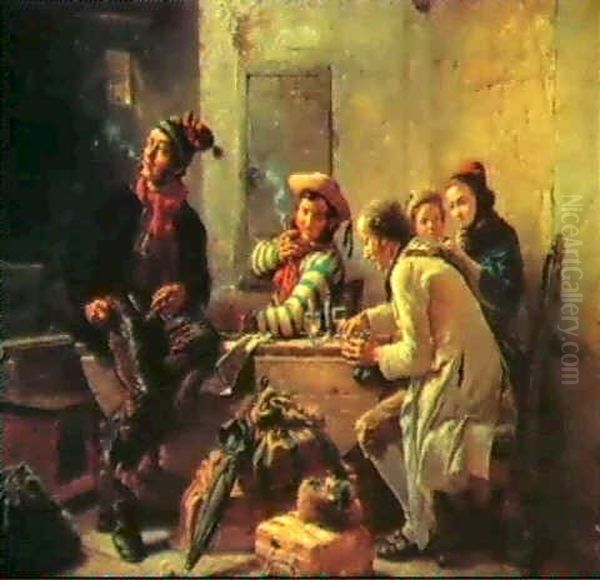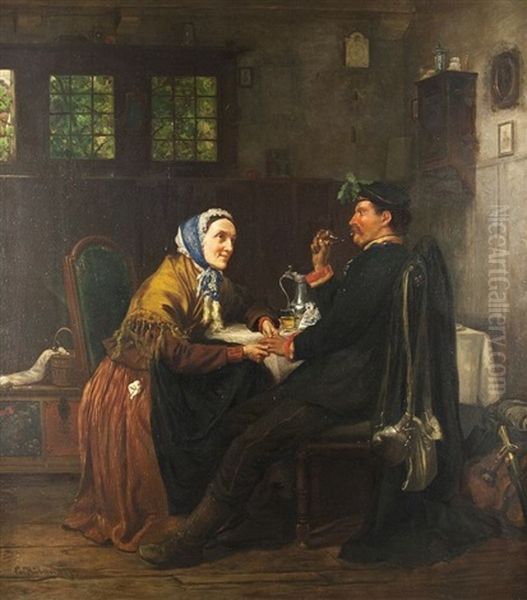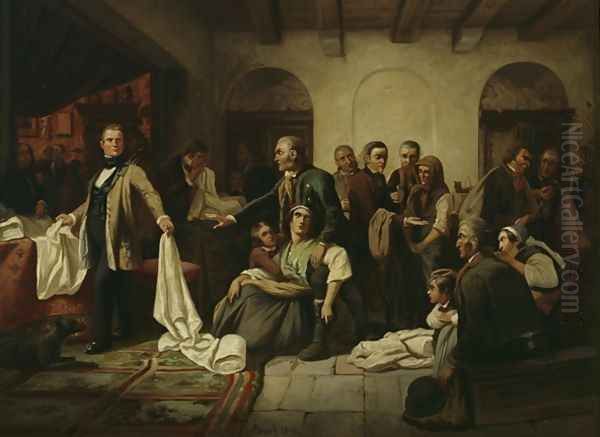
Carl Wilhelm Hübner stands as a significant figure in 19th-century German art, particularly associated with the influential Düsseldorf School of Painting. Born in Königsberg in 1814 and active until his death in Düsseldorf in 1869, Hübner carved a niche for himself as a painter of genre scenes, often imbued with sharp social commentary. His work provides a valuable window into the societal shifts, tensions, and everyday realities of Germany during a period of profound transformation.
Early Life and Artistic Formation
Born into a period of transition following the Napoleonic Wars, Carl Wilhelm Hübner's artistic journey began in earnest when he moved to Düsseldorf. The city was rapidly becoming a major centre for the arts in the German-speaking lands. In 1837, at the age of 23, he enrolled in the prestigious Düsseldorf Art Academy (Kunstakademie Düsseldorf), an institution that would shape his artistic direction and connect him with a vibrant community of artists.
The Academy, under the directorship of the renowned painter Wilhelm von Schadow, was a crucible of artistic thought and practice. Schadow, himself a proponent of the Nazarene movement's ideals initially, fostered an environment that emphasized technical skill and often drew on historical and religious themes. However, the Academy was also large enough to encompass diverse artistic tendencies.
During his time at the Academy, Hübner studied under key figures including Wilhelm von Schadow himself and, notably, Carl Ferdinand Sohn. Sohn, a respected painter known for his historical subjects and portraits, would have imparted rigorous training in drawing and composition. This academic grounding provided Hübner with the technical skills necessary to pursue his own artistic vision.
The Düsseldorf School Context
The Düsseldorf School of Painting was not a monolithic entity but rather a dynamic hub that attracted artists from across Germany, Scandinavia, Russia, and even America. During the period Hübner studied and worked there (roughly the 1830s to the 1860s), the school was arguably the most prominent art centre in Germany. Its reputation was built on a foundation of strong academic training and a diverse output that included history painting, landscape, and increasingly, genre painting.

Key figures associated with the school during or around Hübner's time included the director Wilhelm von Schadow, the history and landscape painter Karl Friedrich Lessing, the celebrated landscape artists Andreas Achenbach and his brother Oswald Achenbach, and Hübner's own teacher Carl Ferdinand Sohn. These artists contributed to the school's fame, though their styles and subjects varied considerably.
Within this environment, a significant trend towards Realism and genre painting emerged, partly as a response to the changing social and political landscape of the Vormärz period (the years leading up to the 1848 Revolutions). Artists began to turn their attention away from purely historical or idealized subjects towards the depiction of contemporary life, including its struggles and social inequalities. Hübner became a leading exponent of this direction.
Hübner's Artistic Development and Style
After his studies, Hübner established himself as an independent artist, opening his own studio in Düsseldorf around 1841. This marked a crucial step in developing his individual artistic voice. He gravitated strongly towards genre painting – scenes of everyday life – but infused his work with a distinct social consciousness that set him apart from artists focused purely on anecdotal or sentimental Biedermeier scenes.
His style is best characterized as a form of Realism, sometimes termed Social Realism. He employed a detailed, narrative approach, carefully rendering figures, clothing, and settings to create convincing depictions of specific social situations. While rooted in the academic techniques learned at the Academy, his focus shifted from idealized beauty or historical grandeur to the often harsh realities faced by ordinary people, particularly the working class and the marginalized.
Hübner's paintings often tell a story, inviting the viewer to contemplate the circumstances and emotions of the figures depicted. His compositions are typically well-structured, guiding the eye through the narrative elements. His palette could sometimes be sombre, reflecting the serious nature of his subjects, aligning with a tendency seen in other Düsseldorf painters dealing with dramatic or realistic themes.
Themes of Social Commentary
Hübner gained particular recognition for his willingness to tackle difficult social issues, earning him a reputation as a painter of the "other side" of society. His work often reflected the profound impact of early industrialization, poverty, and social unrest that characterized the Vormärz period and the subsequent decades in Germany. He seemed particularly drawn to depicting moments of crisis, injustice, or hardship.

His subjects frequently included the rural poor, struggling artisans, emigrants, poachers, and those caught in the gears of societal change or legal systems. Unlike purely picturesque genre scenes, Hübner's paintings often carried an implicit critique of social conditions, highlighting the plight of the vulnerable and the disparities within society. He was noted, alongside contemporaries like Johann Peter Hasenclever, for exploring themes that resonated with contemporary social debates.
This focus on social commentary aligned Hübner with progressive currents of the time. His work implicitly questioned existing power structures and highlighted the human cost of economic hardship and social inequality. This engagement with contemporary reality made his paintings relevant and often provocative to audiences of his day.
Major Works: Reflecting Reality
Several key works exemplify Hübner's artistic concerns and style. Perhaps his most famous painting is Die schlesischen Weber (The Silesian Weavers), likely created around 1844 or shortly after, depicting the dire conditions of weavers facing industrial competition. This work directly referenced the Silesian weavers' uprising of 1844, a significant event that drew widespread attention to the plight of artisans displaced by mechanization. The painting powerfully conveys the poverty and desperation within the weaver's cottage, serving as a visual counterpart to contemporary writings like Heinrich Heine's poem of the same name. This painting is now held in the Deutsches Historisches Museum.
Another significant theme Hübner explored was the conflict arising from property laws and traditional rights, particularly concerning hunting. Works like Das Jagdrecht (The Game Laws) or variations titled Der Tod des Wilderers (The Poacher's Death) depict the often tragic consequences faced by poor individuals caught poaching, highlighting the harshness of laws perceived as favouring the landed gentry over the needs of the common people. These paintings often feature dramatic confrontations or scenes of familial grief.
The theme of emigration, a major social phenomenon in 19th-century Germany as many sought better opportunities abroad, particularly in America, was also addressed by Hübner. Paintings titled Die Auswanderer (The Emigrants) likely captured the emotional moment of departure or the uncertain prospects faced by those leaving their homeland, reflecting another significant aspect of contemporary social experience.
The print Die Heimkehr (The Homecoming), based on a painting by Hübner, suggests a focus on familial narratives and perhaps the return of a soldier or worker, themes common in genre painting but likely treated by Hübner with his characteristic attention to emotional and social context. These works collectively demonstrate his commitment to portraying the lived experiences and social dynamics of his time.
Technique and Reception

Hübner's technique was grounded in the Düsseldorf tradition of careful drawing, detailed rendering, and strong narrative composition. He paid close attention to costume, setting, and physiognomy to enhance the realism and emotional impact of his scenes. While adhering to academic principles of structure, his work sometimes prioritized expressive content and social message over idealized form, leading some contemporary critics, perhaps wedded to stricter academic standards, to find his style lacking in polish.
Despite this, Hübner achieved considerable popularity. His subjects resonated with a public increasingly interested in contemporary social issues. Furthermore, his paintings were widely disseminated through reproductions, such as engravings and lithographs, which made his work accessible to a broader audience beyond those who could view the original canvases in exhibitions or collections. This reproductive afterlife significantly contributed to his fame and influence.
His engagement with social themes placed him at the forefront of a critical realism that was gaining traction in German art, offering a counterpoint to the more romantic or historically focused wings of the Düsseldorf School. His success demonstrated a market and an appetite for art that grappled with the complexities of modern life.
Relationship with Contemporaries
Carl Wilhelm Hübner worked within a rich artistic milieu in Düsseldorf. While specific records of close personal friendships or collaborations might be scarce, his thematic concerns clearly aligned him with certain contemporaries. Johann Peter Hasenclever, for instance, was another prominent Düsseldorf genre painter known for his humorous and sometimes critical depictions of everyday life and social types. Artists like Philipp Hoyoll and Wilhelm Kleinenbroich were also mentioned in sources as sharing an interest in contemporary social issues, suggesting a shared sensibility among a segment of Düsseldorf artists.
Hübner's work can be situated within the broader context of European Realism. While distinct from the French Realism of Gustave Courbet or Jean-François Millet, Hübner shared their commitment to depicting ordinary people and contemporary life, albeit often with a more narrative and sometimes moralizing tone characteristic of German genre painting. In Germany itself, Adolph Menzel in Berlin was another major figure of Realism, though his focus and style differed from Hübner's.
Within the Düsseldorf Academy itself, Hübner's focus on social genre painting existed alongside other strong traditions. The landscape painting of Andreas and Oswald Achenbach offered dramatic views of nature, while Karl Friedrich Lessing continued to produce significant historical paintings. History painting itself saw dramatic interpretations by artists like Alfred Rethel and the German-American Emanuel Leutze, famous for Washington Crossing the Delaware, who also studied at Düsseldorf. Other notable Düsseldorf contemporaries included Theodor Hildebrandt and Rudolf Jordan, who also worked in genre and historical themes. Later figures associated with Düsseldorf genre painting, like Ludwig Knaus and Benjamin Vautier, would continue and evolve the tradition.
Later Life and Legacy
Carl Wilhelm Hübner remained active as an artist in Düsseldorf throughout his career. He continued to produce genre paintings that reflected his enduring interest in social observation and narrative. Information about extensive travels or significant shifts in his later style is limited, suggesting he largely remained committed to the artistic path he established in the 1840s. He passed away in Düsseldorf in 1869.
Hübner's legacy lies primarily in his contribution to the development of social realism within the Düsseldorf School and German art more broadly. He was one of the first German artists to consistently place the social problems and everyday struggles of ordinary people at the centre of his work. His paintings served as important visual documents of their time, capturing the anxieties and realities of a society undergoing rapid industrial and social change.
His influence can be seen in the subsequent generations of genre painters in Germany who continued to explore contemporary life and social themes. By tackling subjects like poverty, labour unrest, and emigration, Hübner helped to expand the boundaries of acceptable subject matter for painting, demonstrating that art could engage directly and critically with the pressing issues of the day.
Conclusion
Carl Wilhelm Hübner was more than just a skilled painter of the Düsseldorf School; he was a visual commentator on his times. Through his detailed and often poignant genre scenes, he captured the human dimension of 19th-century German society, focusing particularly on the lives of the working class and the marginalized. Works like The Silesian Weavers remain powerful statements about social injustice. While rooted in the academic traditions of Düsseldorf, his commitment to realism and social commentary marks him as a significant figure in the transition towards modern art in Germany, leaving behind a body of work that continues to offer insights into the social fabric of his era.